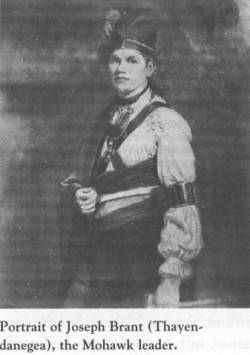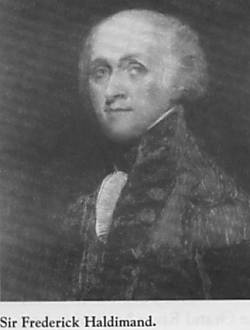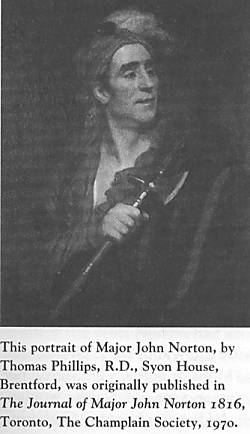|
From the Haldimand Grant to the Grand River
Navigation Company
Caledoniaís story begins with the aftermath of the
American Revolution. On October 25, 1784, the British Crown gave Mohawk
Chief Joseph Brant and his Six Nations Confederacy six miles of land on
either side of the Grand River beginning from its mouth at Lake Erie to
its source in present-day Dufferin County. This land grant was given in
gratitude for their services and loyalty to the Crown during the American
revolutionary war and in response to their application for recompense for
their lands lost to the United States.
 The
grant was completed by Sir Frederick Haldimand, Governor-in-Chief of
Canada, after whom the county is named and subsequently the entire
regional municipality. That same year Chief Brant invited some white
Loyalist friends who were refugees from the Revolution, to settle with him
in the Grand River Valley. In turn Brant gave them tracts of land along
the river. The
grant was completed by Sir Frederick Haldimand, Governor-in-Chief of
Canada, after whom the county is named and subsequently the entire
regional municipality. That same year Chief Brant invited some white
Loyalist friends who were refugees from the Revolution, to settle with him
in the Grand River Valley. In turn Brant gave them tracts of land along
the river.
One of these friends was Henry
Nelles and his sons. They were allotted a block in Seneca Township, three
miles back from the river bank and three miles broad, plus a small tract
in Oneida on the south side. Adam Young and his sons were also given a
large tract in Seneca further east beyond York, a village along the banks
of the Grand. There were no roads or easy access and no improvements in
the area. The Nelles and Young families began the back breaking labour of
clearing the land by hand. Later others would come and settle mainly
around Oneida.
Shortly after 1830 the government,
with the consent of the Chiefs, decided to sell all the remaining portions
of the reserve in Haldimand, except for a small section in Oneida, and
open this area for development. The proceeds were to be invested for the
benefit of the Indians, with the interest on the investment being paid in
goods such as guns, blankets, and ammunition. Consequently, a treaty was
concluded that resulted in the surrender of the lands to the government
and the opening up of the townships for white settlement.
 In
1832 a bill was passed by the provincial government authorizing canal and
lock building on the Grand, or Ouse River as it had been known. The
success of the Rideau Canal and the new Welland Canalís feeder line to
Dunnville had opened up the Grand, making commercial navigation possible.
Already the Dunnville Dam, which had been built in 1829, allowed boats to
travel through Cayuga to the nearby village of Indiana. In
1832 a bill was passed by the provincial government authorizing canal and
lock building on the Grand, or Ouse River as it had been known. The
success of the Rideau Canal and the new Welland Canalís feeder line to
Dunnville had opened up the Grand, making commercial navigation possible.
Already the Dunnville Dam, which had been built in 1829, allowed boats to
travel through Cayuga to the nearby village of Indiana.
In the entrepreneurial spirit of the
time The Grand River Navigation Company was formed. With John Jackson as
engineer, more dams, canals and locks were to be built. Travel on up the
river from Indiana to Brantford could be made possible. Timber, gypsum and
grain products would move more rapidly. By 1833 dams one, two and three
were completed at Indiana, York and Sims Locks. Dam four, just east of
what we know as Caledonia today, was in place in 1834.
The Navigation Company laid out small villages on north
and south banks of the Grand. The village of Seneca was located on the
north bank at Dam four, while the village of South Seneca was on the south
bank. By 1834 Jacob Turner, the contractor for dam four, was operating a
sawmill at Seneca Village. Settlers were beginning to establish other
businesses in both the north and south sites. Dam five, about a mile to
the west at Oneida, was yet to be built. Once Ranald McKinnon was assigned
as the contractor, he built a sawmill on the north bank right at that
location as was the practise of the time. This marked the beginning of the
village of Oneida on the north bank and Sunnyside on the south bank.
When McKinnon first arrived in the
area he came upon Bryantís Corners, a hamlet consisting of two log houses
and a tavern owned by Mr. Bryant. Today, Bryantís Corners is the main
corner of Caledonia at Caithness and Argyle Street, midway between what
was then Seneca Village and Oneida Village.
Thereís More To The Legend:
Captain John Norton
He deserved more acclaim than he was
given. He did not deserve the legendary inaccuracy he received. A story of
John Norton, passed down through the years and written under the title of
The Last Duet in Canada created some widespread notoriety, but
there was much more to John Norton than the duel fought in the latter
stages of his life.
 Captain
John Norton (Teyoninhokarawen) was born about 1760 to a Cherokee father
and a Scottish mother in the country of the Cherokees. In 1795 he arrived
at the Grand River settlements to be an interpreter among the Grand River
Indians. His years of education in Scotland, his linguistic abilities and
personal flair had prepared him for leadership with his people. Captain
John Norton (Teyoninhokarawen) was born about 1760 to a Cherokee father
and a Scottish mother in the country of the Cherokees. In 1795 he arrived
at the Grand River settlements to be an interpreter among the Grand River
Indians. His years of education in Scotland, his linguistic abilities and
personal flair had prepared him for leadership with his people.
In 1823 when John Norton was about
60 years old, he owned Hillhouse, a mansion of the day located atop a hill
along the Grand River just east of what is now known as Caledonia. By then
he was a prominent citizen accepted as a Mohawk of the Grand River
community and highly respected among those he lobbied in England on behalf
of the Indian nations. But he left after the duel fought at Hillhouse,
never to be heard of again.
It wasnít until 1970 when the
Champlain Society of Canada published The
Journal of John Norton 1916, edited with
introductions and notes by Carl F. Klink and James J. Talman, that the
full Norton story became known. The Champlain Society was given permission
to print the manuscript by His Grace, the tenth Duke of Northumberland.
Captain Norton had been commissioned
by the second Duke of Northumberland to write this journal while
documenting a journey of a thousand miles down the Ohio in 1809. In this
account he described the Five Nations as well as describing his way to the
Cherokee country of Tennessee in 1809-10 and recorded his campaigns in the
War of 1812-14. Nortonís journals are published in two volumes with forty
pages given to a table of contents and a dedication to the second duke,
nine hundred and sixty-seven pages for text and twenty-three pages of
vocabulary.
By 1799 Joseph Brant had conferred
the title of war chief upon him. It is said that his accomplishments
exceeded Brantís anticipations as Norton lobbied on behalf of the Indians,
taught them agriculture and dealt with their land claims. Following Joseph
Brantís death on November 24, 1807, John Norton became their respected
spokesman and leader.
Nortonís exceptional career
encompassed the difficult early history of Upper Canada. Especially
complicated were dealings concerning the place of the Six Nations, their
land claims and the lobbying that had to be conducted with the British
Government during Joseph Brantís time and after.
One description of Norton tells us
that he spoke the language of about twelve different Indian nations, as
well as English, French, German and Spanish, and that he was an avid
reader in possession of all the modem literature of the day. Another said
he was a man of great natural acuteness, possessing much reflective
ability united with a sense of religion and an ardent devotion to the
interest of his tribes. A physical description tells us that "he was 6
feet tall, well made, active, possessing a dark complexion, mild with
pleasing manners and prone to wearing clothes of English fashion."
On July 27, 1813 immediately following the War of 1812,
Norton wed Catherine Munn (also known as Maus, Mons or perhaps Docherty;
her native name was Karighwaycagh), a sixteen year old Native woman. They
were married by Reverend Robert Addison in Niagara. Catherine had been
brought up by her grandmother along the Grand River. Her father was said
to have been white. Norton took Catherine and his ten year old son John
from a previous marriage, to Dunfermline, Scotland where they attended
school in the care of Mr. and Mrs. Johnstone, friends from Nortonís own
hometown. Young John was to stay to complete his schooling while Catherine
returned to Canada with her husband in 1817.
That year Captain Norton promised
Reverend Robert Addison, the Anglican missionary with the Church of
England to Niagara and the Indians at Six Nations, that he would translate
the gospels of the Bible into Mohawk. Although he had completed the
translation of St. Matthew by 1821, he was worried that the rest would be
of little use and did not complete the task. Later Aaron Hill and Dr. John
Strachan would finish the work begun by Norton.

Over the years Norton had acquired a
large tract of land of about 925 acres overlooking the Grand River below
Caledonia which we know today as the area of Sims Lock. This is where
Hillhouse was built for him and his wife. The farm managerís small log
house still remains as a reminder of its history. Today, the road (Highway
54) is to the south of the log house. However, when Hillhouse was
just a few feet west of the log house, the road ran north of the house. It
was here that the duel was to be fought.
The story of the so-called ĎLast
Duel in Canadaí begins when Nortonís life took an unfortunate turn at
hay-making time in 1823. His debts had been increasing to the degree that
the Third Duke of Northumberland had paid for young Johnís education.
Depressed by his lack of funds and his corresponding inability to travel,
he was growing restless and feeling limited in his role as farmer. Over
the years he had enjoyed being a celebrity, called upon to verify war
records of Indians and settlers and recommended by influential friends to
those seeking advice. Now his life was restricted and confining.
One day Catherine complained to her
husband of a young man making advances to her. The distraught Norton
abruptly sent notice for both of them to leave the area. The Champlain
Society published word for word, John Nortonís own account of the incident
as written in a letter to his friend, Colonel John Harvey, a veteran of
the War of 1812. He began by saying an unfortunate affair had occurred at
his place that had filled his heart with vexation and grief. The young man
his wife had complained about was Joseph Big Arrow, a person Norton had
affectionately fostered from childhood.
Neither individual had obeyed
Nortonís notice. When the young man came to the house, Catherine rushed
downstairs and accused him to his face, "upbraiding my moderation", said
Norton. He didnít exactly remember what he said, but he knew he felt angry
yet reluctant to hurt him. When the young man dared Norton, Norton told
him to choose his weapons, noting in his letter that the young man should
have an equal chance. As he took his pistol and prepared
it, Norton noted
that there were several people standing by.
"I told him that when he took aim at
me and I saw him ready to fire I would treat him as I did my enemies ó he
advanced taking the rising ground on one side until within three paces,
when he presented at my head: after firing, it appears he sprung upon me:
and had seized or in some manner changed the direction of the pistol for
the ball passed downward and through his thigh, while his ball grazed the
top of my head." This Norton described in the letter.
According to the trial transcripts,
Joseph Big Arrow of Bearfoot Village on the Grand River, died about
forty-eight hours later. Witnesses were reported to have said that Norton
lamented at what had happened and was heard to say, "Oh, my Joseph."
His letter expressed his ongoing
feelings of pity and distress and identified that on the third day friends
told him he should leave home in anticipation of a change of situation
which might afford relief of mind. He told Colonel Harvey that he had
written to the Attorney General offering himself for trial, naming as many
witnesses as he had remembered. He also stated that he was going to take a
young Cherokee friend to his country where he would remain for the winter,
a trip he had been wanting to take.
Although Norton had not named the
young man he had challenged to a duel, his son John, by this time a young
man himself, in writing to his father to tell him to leave because of the
familiesí embitterment, indicated that the fellowís English name was
Crawford. John had also proposed that a settlement be made to the injured
family as it
was an Indian custom.
Following his trial in Niagara,
Norton described the proceedings for Colonel Harvey saying he had been
kept in prison until the verdict was announced; a fine of twenty-five
pounds. Big Arrow, (Joe Crawford) had left a widow and two children. He
noted that Big Arrowís pension might be allowed to continue to his family
for a little time.
Norton refused to see his wife.
Catherine wrote to him on August 3, 1823 pleading that he not believe all
that people were saying against her. She had left with only a blanket. A
trunk had been sent to her later with many things taken out. She said she
had heard they wanted to kill her, but that she believed it was all false.
She wrote, "God forgive me my sins, I will never forget it all the days of
my life." She ended by saying she hoped Norton would not forsake her all
together and asked again for his forgiveness.
There is evidence to conclude,
according to The Journal, that Norton had directed his pension to
Catherine, with the last payment made on February 25, 1826. There is also
evidence to conclude that Catherine went to Moraviantown on the Thames
River which is in the St. Thomas area of today. She died January 16, 1827.
The Niagara Gleaner printed
the account of the trial on September 20, 1823. It said Norton would no
doubt have been acquitted altogether if he had not, from feelings of
delicacy, withheld his best defense.
Norton left for Cherokee country
following the trial, where it
is believed he lived until his death in October 1831.
Hillhouse Farm was looked after by the farm manager, Robert Thomson, until
1838 when Charles Bain purchased the land from the government. The
surrender document, which the Bain family still have in their possession,
is signed by forty Indian Chieftains. The money from the sale went into a
fund on which the Indians drew interest. The original home burned in 1838
and in 1840 the present house was built.
John Norton Jr. returned to Canada
to live on the Huff Tract near Cayuga where he had received a patent from
the Crown for 388 acres. On August 3, 1840 he sold this property and moved
to Thamesville.
A memorial to Captain John Norton
was placed in a stained glass window of the historic Mohawk Chapel in
Brantford where it can be seen to this day. The inscription reads,
"installed with the gracious approval of Her Majesty Queen Elizabeth II to
commemorate the special association for the Chapel of the Mohawks with the
Royal Family. Dedicated on May 27, 1962, the 25th anniversary of the gift
of a Bible ĎTo Her Majestyís Chapel for the Mohawksí by Queen Anne in
1712, this window portrays the distribution of the Gospels in Mohawk in
1806."
"Let us strictly adhere to what our
Lord has transmitted to us in the Holy Scriptures, that thereby the
unbelievers may know the love we bear the commandments of God. Preface to
St. Johnís Gospel ó Captain John Norton." |
